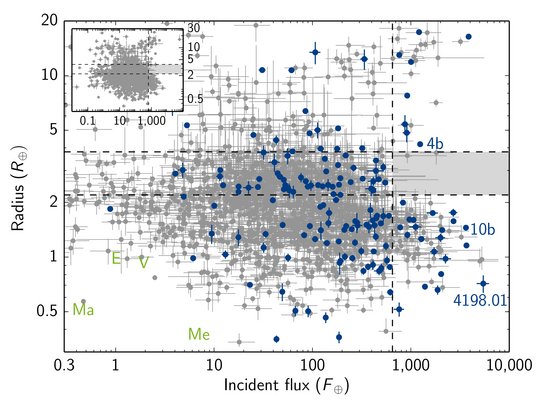Don't come too close to the stars if you are a super-Earth
Coming too close to the fire will get your fingers burnt. This old adage is also valid for exoplanets orbiting remote stars. Mia S. Lundkvist and a group of astronomers, of which many are affiliated with the Stellar Astrophysics Centre at Aarhus University, Denmark, have shown that it is also true in the real world. In the newly published paper titled "Hot super-Earths stripped by their host stars" in Nature Communications the researchers explain their methods and results.
![[Translate to English:] Boiling atmosphere. Drawing: Peter Devine](/fileadmin/site_files/nyheder/Hot_super-Earth_image_Peter_Devine.jpg)
Coming too close to the fire will get your fingers burnt. This old adage is also valid for exoplanets orbiting remote stars. This is not a big surprise to anyone in the astronomical business, and theoretical calculations have already pointed this out. Now Mia S. Lundkvist and a group of astronomers, of which many are affiliated with the Stellar Astrophysics Centre at Aarhus University, Denmark, have shown that it is also true in the real world.
In the newly published paper titled "Hot super-Earths stripped by their host stars" in Nature Communications the researchers explain their methods and results.
What goes wrong for the super-Earths?
Planets with diameters beetween 2.2 and 3.8 times bigger than the Earth, and orbiting so close to their parent star that they recieve more than 650 times more starlight than what we on Earth recieve from the Sun, will loose their atmospheres due to the intense high energetic radiation from the star. The outer layers of these planets, consisting of a rocky core and a thick atmosphere of gasses, will be heated by the radiation, causing the volatile materials to boil away and disappear into space, leaving the 'naked' planetary cores. It might be compared to being far too close to a hair dryer on full heating power. For the discovery the researchers have been using data from the NASA Kepler mission. Head author Mia S. Lundkvist explains: "The lack of warm planets slightly larger than the Earth, has been suspected for some time. Our results have finally confirmed what theory predicts." Mia adds: "These results are an important step towards understanding how planetary systems evolve. Studying our own Solar system has not helped in this connection. We do not have this type of planets here. Planets Uranus and Neptune are of the right sizes, but they orbit far from the Sun, in much colder regions."

In a diagram like this, with exoplanets placed according to size along the vertical axis and radiation flux along the horizontal axis, the astronomers have discovered a 'desert' where no planets exist. This is the hatched area to the right.
How do we know?
How close an exoplanet can approach it's star before the volatile constituents boil up and are blown away into space can be calculated from theory.
A missing group of exoplanets in the "exoplanets' zoo" has therefore been expected. The new results from the team of researchers now confirm this, using asteroseismology. In ordinary seismology, geologists study the innards of the Earth using oscillations caused by earthquakes and explosions. Asteroseismology is a bit of the same. A stars is an enormous ball of hot gasses, and it vibrates like a huge bell or a salad bowl of crystal. These vibrations or oscillations can be observed by Kepler, as very small changes in the light output of the star enable the astronomers to 'see' into the star.
Kepler has observed some 2 000 exoplanets, and more are due in the future. The planets are discovered because the cast a small 'shadow' for a few hours while transiting in front of the star, as seen from Earth. By combining measurements of these transits with asteroseismology, the diameter of the planet and the flux, i.e. the total radiation from the star, it receives can be calculated with much higher precision than has previously been possible. Mia S. Lundkvist explains: "We have used asteroseismology as a very good ruler, enabling us to determine the sizes of the exoplanets together with with the flux recieved from their stars."
Confirmation of 'The Desert'
Out of the group of authors, 29 in total most are or have been asociated with the Stellar Astrophysics Centre at Aarhus University, Denmark.
Head author is the young PhD Mia S. Lundkvist, presently working at Zentrum für Astronomie at Heidelberg University, Germany. Mia Lundkvist comments: "For some time we have known that this 'desert' should be there, but now we can see that it is true, after having worked through asteroseismic Kepler data from 102 stars and having calculated 10 million possible scenaria to ensure that what we see here is not only statistical fluctuations. The 'desert' is there, and it is exactly where we expected it to be."
What happens to the stripped planets?
If all the volatiles around a super-Earth have been blown away, what is left? The heavier elements, forming the nucleus of the original planet, will hardly be stripped away by even the strongest stellar radiation, causing the researchers to expect that these 'naked' planetary remnants can be detected and characterized in the future. One of the tools for that will be NASA's TESS mission to be launched in 2017.
link to article www.nature.com/search
